It’s treated like the strict school principal of business. It’s seen as boring and “unfun.” It won’t let you tell jokes, talk to your friends on social media, or break with tradition. (And it certainly wouldn’t let you chew gum in class if it could.)
However, if my last decade of helping marketers promote their businesses has taught me anything, it’s that these are all just nasty rumors.
B2B (business-to-business) marketing, especially social media marketing, can be just as creative, relatable, and exciting as B2C (business-to-consumer), and frankly, it has to be to be successful.
Thankfully, there are a number of B2B social media marketing strategies and tips that make it possible, regardless of your industry. Let’s talk through some of the best and look at examples from brands like Google, Slack, Shopify, and more.
Table of Contents
- What is B2B social media marketing?
- So, how is B2B social media marketing different from B2C?
- B2B Social Media Marketing Strategy Best Practices
- B2B Social Media Marketing Tactics That Work for Any Industry
What is B2B social media marketing?
To understand B2B social media marketing, you really just need to understand the difference between B2B and B2C.
Simply put, B2B means a business' offering is intended to be bought and used by another business. It has a professional purpose.
B2C, on the other hand, refers to goods and services intended to be bought by individual consumers for personal use.
Pretty straightforward, right?
Knowing that, B2B social media marketing is when your business uses social media platforms to promote its product, service, or brand to other businesses that may buy them.
Think Shopify targeting eCommerce businesses or Slack, businesses that need real-time digital communication.
But let’s be real — it’s not like Slack or Shopify themselves are scrolling through your Instagram feed or slapping subscribe on YouTube. It’s still an individual.
So, I usually recommend my fellow marketers to think of B2B social media marketing as when a business uses social media to reach individuals who make purchases on behalf of businesses or can influence those purchases.
So, how is B2B social media marketing different from B2C?
Even though B2C and B2B social media marketing both technically speak to individuals, there are still some key differences.
And they all primarily come back to what messages and content you share.
In B2B social media marketing, you speak more about professional and organizational pain points and goals (i.e., profitability, productivity, and team morale) and very rarely about personal goals (i.e. better home life, improved health, or beauty).
B2B is also less about developing personal, one-on-one relationships on social media like B2C and more about communicating value and bottom-line results to a greater organization.
However, none of this is to say that B2B social media marketing is cold, heartless, or impersonal.
If you’re working B2B social for the first time, it simply means you want to focus on the collective interests, not personal ones.
Share customer success stories or content that speaks to common organizational pain points or experiences. Post data or actionable advice businesses can use in their projects or initiatives.
Slack does a great job of this across its social media.
Now that you know what B2B social media marketing is, how can you do it successfully?
B2B Social Media Marketing Strategy Best Practices
First, you need a solid B2B social media marketing strategy to guide you. Let’s discuss a few best practices for creating yours.
1. Shape your strategy around SMART goals.
Like any marketing strategy, a B2B social media strategy must be shaped around goals to succeed. Goals guide you and ensure you’re working toward the right things.
Whether your goals are focused on brand awareness or acquisition, the best way to outline them for your team is using the SMART methodology — specific, measurable, attainable, relevant, and time-bound.
This helps your team know exactly what it’s trying to do and by when, how it will track its progress toward achieving it, and why it’s something they can actually do.
Let’s illustrate with an example. Say your goal is “To build brand awareness on social media.”
Thinking this through with the SMART methodology, this becomes:
- Specific: I want to boost our company's brand awareness by posting regularly and frequently on X, Instagram, LinkedIn, and Facebook. I will increase our posts on X from once to four times a day, post daily on Instagram, and increase weekly publishing frequency on LinkedIn and Facebook from four to seven times per week.
- Measurable: Our goal is a 4% increase in engagement rate across the board.
- Attainable: Our engagement rate increased by an average of 2% last month when we increased our weekly publishing frequency and spent more time on thoughtful, engaging copy.
- Relevant: By increasing the engagement rate, we'll boost brand awareness and generate more leads, giving sales more opportunities to close.
- Time-Bound: End of this month.
Putting that all together makes our SMART goal:
“By the end of this month, we will increase our average engagement rate across our social media channels by 4% by increasing our post frequency and concentrating on thoughtful, engaging copy.”
See the difference?
Pro tip: If you need help thinking through the SMART methodology, we have a template to help.
Available as an Excel and Google Sheet, this template provides step-by-step instructions for setting a SMART goal, calculates achievable numerical targets, and helps you evaluate the roadblocks to achieving your marketing goals.
2. Take inspiration from your competitors.
Social media can give you a glimpse into your competitor's marketing strategy. Monitoring them should definitely be part of your routine.
You want to know what campaigns they run, how audiences respond, what new products or features they may launch, and what questions or problems audiences may have.
All of this insight helps you better understand what you’re up against and how you may need to adjust your strategy.
You also want to “Find a white space,” Emily Kearns, Senior Manager, Brand Social at HubSpot advises.
“The B2B landscape is relatively straightforward, similar, and dull. Deep dive into your competitors, see how they’re executing on social, and try to determine a unique area where you can add value and stand out.”
If your competitor isn't responding to trending news, then maybe your brand can lead the way. If they find success sharing videos with actionable advice, how can you incorporate a similar style and improve upon it?
Look for opportunities to emulate things that are doing well and differentiate yourself.
3. Establish a unique brand and voice.
You also need to develop a consistent voice on social media. Not only does this make your feed look more organized, cohesive, and professional, but it also allows visitors to recognize your content even out of context.
For example, you can spot a Canva post from a mile away with its consistent fonts and colors.
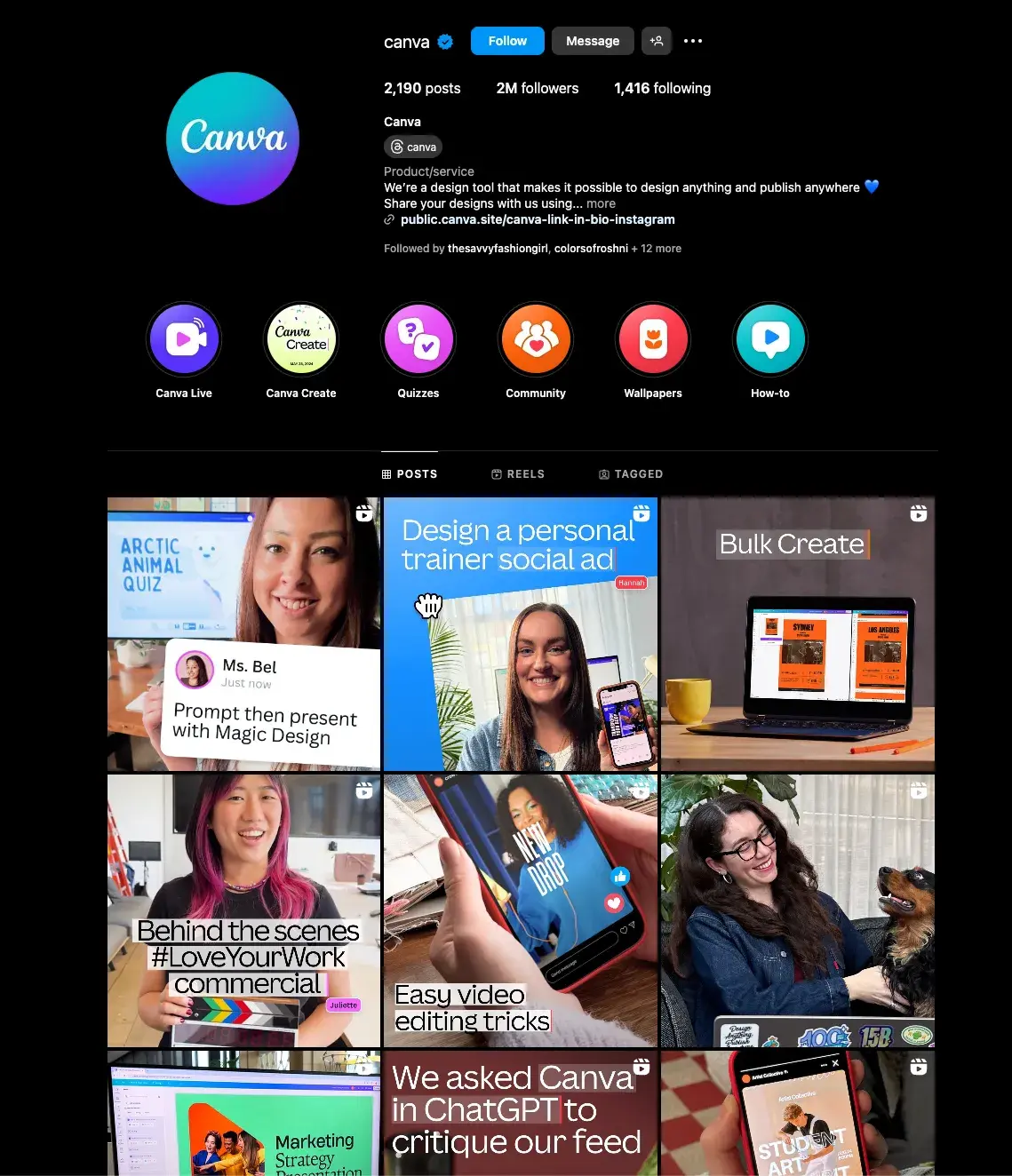
Ask yourself:
- What makes your business different?
- How will its content look and feel?
- What would make someone be able to recognize it even if it wasn’t on your platform?
- What emotions and words do people associate with you?
The answers to these questions will form the foundation of your voice. If you want more tips for building your brand voice from the ground up, here is a helpful slideshow to get you started.
Pro tip: LinkedIn found that 64% of executives prefer “a more human, less formal tone of voice” over “an even-toned, intellectual voice.” So, keep it natural and conversational.
“Think of your brand as a person, a friend to your audience,” details Chi Thukral, Senior Marketing Manager, Brand Social here at HubSpot.
“What would they sound like, what would they be interested in talking about, how would they be at work, what would their FYP look like? This all will humanize your content. B2B doesn’t have to be serious and dry.”
While you want your social media voice to be consistent with your greater brand and company culture, you’re still talking to fellow human beings. Post accordingly.
4. Post on a consistent schedule.
Along with your voice and visual brand, aim to be consistent with your posting schedule.
Having a set time to post content gives you a deadline to follow and gives your audience a specific time to anticipate hearing from you.
Create a content calendar for as far into the future as you can. I recommend mapping out at least two weeks and having your content ready a week before publishing, so you aren’t left scrambling at the last minute.
HubSpot has a social media calendar template to help you get started.
Pro tip: Another way to maintain consistency is to schedule posts ahead of time using a social media tool.
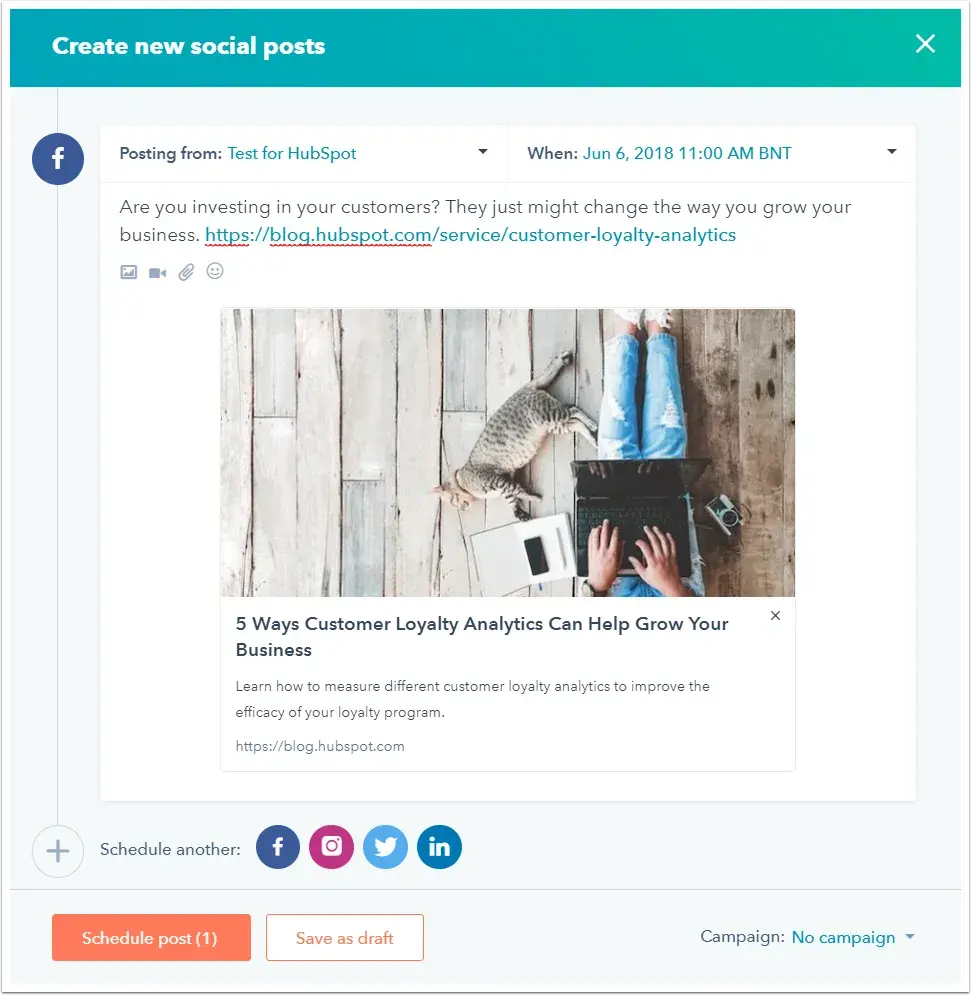
HubSpot’s social media management software allows you to run all your social media from one central location, including scheduling to Facebook, Instagram, X (formerly Twitter), and LinkedIn.
5. Focus on original, thought leadership content.
Looking at the success of all the meme accounts on social media, you may think curating content from other sources is a quick ticket to success — but this approach is short-sighted.
You may get a like or share today, but why should anyone follow you over the original source long-term? Sharing third-party content showcases the talent, unique value, or expertise of its original creator, not you.
So, rather than just curating content from others, aim to share high-quality, original content on a regular basis. Your audience will be more inclined to share original content, in turn exposing your name and knowledge to new audiences.
But what kind of original content should you post?
Consider your audience’s interests, questions, and goals, and create content that addresses them with your unique perspective. Provide answers and points of view only your organization can; insights from your team’s experience.
The possibilities are endless, but if you’re having trouble coming up with ideas, you’re not alone. Creating engaging content is the #1 challenge marketers expect with social media in the next year, but it doesn’t have to be.
We’ll get into specifics in the next section, but you can also head to The Ultimate Guide to Content Creation for some inspiration.
6. Diversify your content mediums.
There's a reason we social media marketers get excited when platforms launch new features. They’re new mediums to play, get creative with, and maybe strike a chord with our audiences.
Instagram Stories, Facebook polls, TikTok Slideshows, and LinkedIn documents are all examples of multimedia formats that added new ways to engage with audiences on their platforms and diversified content mixes.
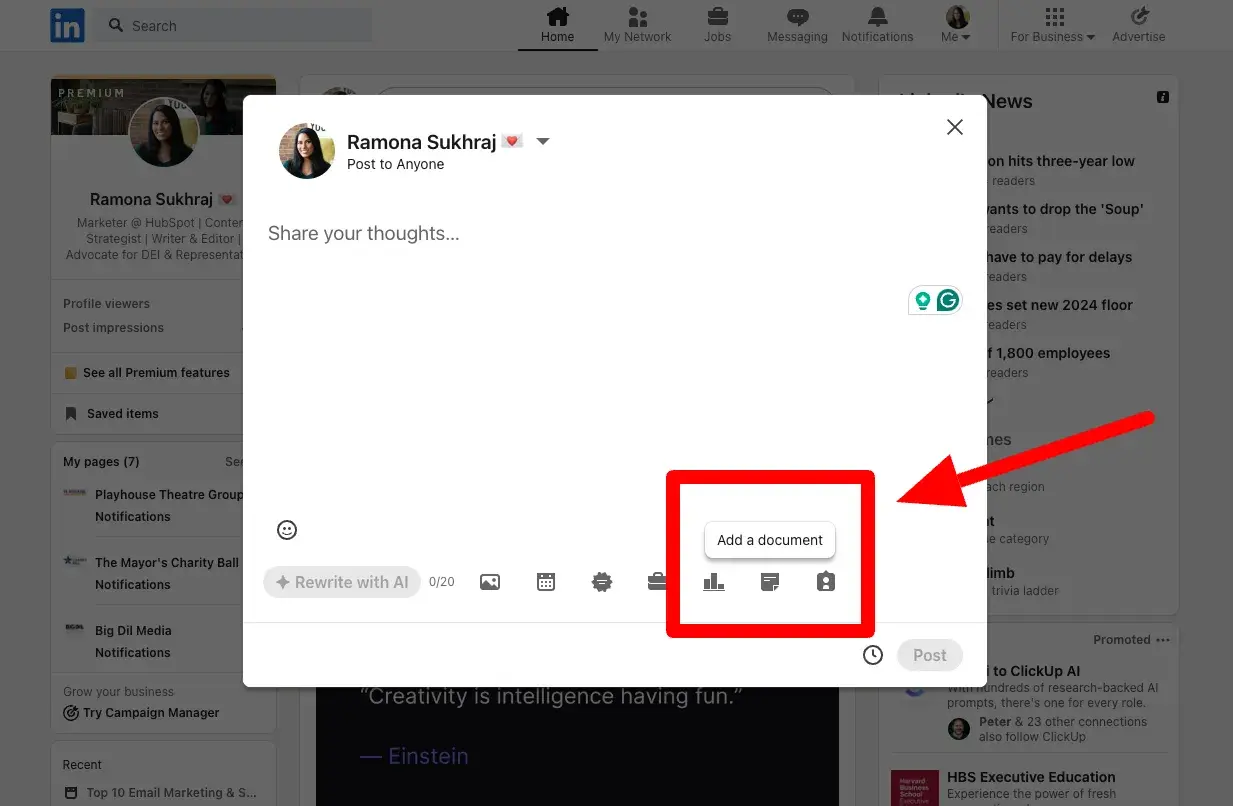
But why does this matter? Think of it this way — If you scrolled through Instagram and only saw photos, you'd probably get bored pretty quickly. Or if you only created the same format everyone else was, you’d likely get lost in the crowd.
Part of the reason Instagram keeps people hooked is because of its variety. In a 10-second scroll, you might come across a meme, a Reel, a Story, an image with a poll, a carousel, or a live video. There’s a potpourri of options to keep people interested and interacting.
This is something you should emulate on your brand’s specific page.
Different people enjoy consuming information in different ways, so if you only create one type, you may be ignored by many in your target audience.
Plus, not every topic lends itself to every format. For example, a software tutorial is likely best suited for a video rather than a series of photos. So, let your subject matter guide you as well.
Office space provider Regus uses a healthy mix of different mediums across its social media profiles. On Instagram, you’ll find short-form videos, Stories, single photos, carousels, and even graphics to diversify its feed and highlight offers in different ways:

And their LinkedIn follows suit with videos, slideshows, and graphics:

Pro tip: Repurpose your existing content for different mediums with artificial intelligence (AI). Repurposing is one of smartest ways to get the most out of the work you’ve already done and it doesn’t have to be time consuming, thanks to AI.
Share a blog article with ChatGPT and it can quickly spin up drafts for social media posts or captions. It can even create video scripts or even images and graphics.
There are also an increasing number of AI tools being explicitly built with content repurposing in mind like HubSpot’s Content Remix.
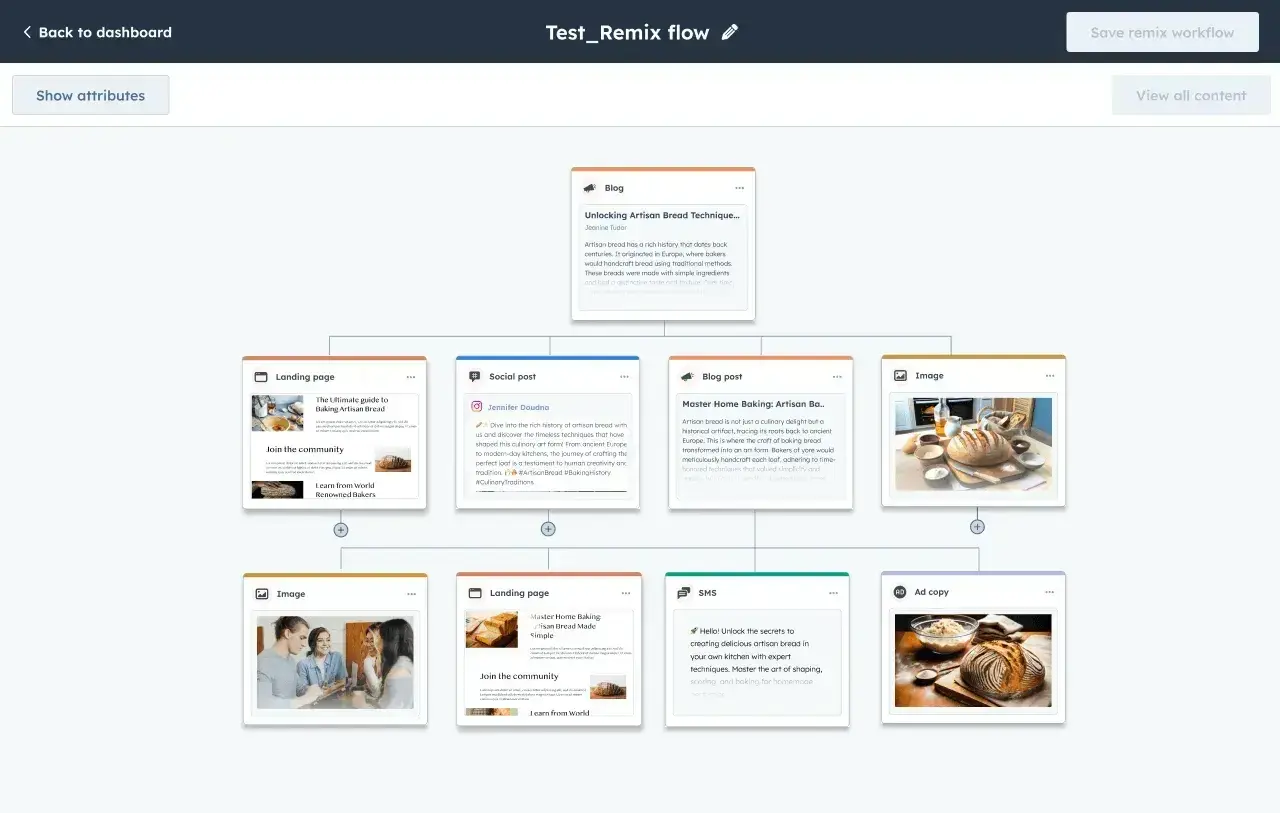
With Content Remix, Professional and Enterprise-level users of Content Hub can repurpose existing content into new formats.
This can be materials you have hosted on HubSpot (i.e. images, social posts, text messages, ads, and blog posts) or new content you upload to the tool.
7. Use AI — but sparingly.
Speaking of AI, it can dramatically help you save time in B2B social media marketing in a number of ways. It can help you:
- Generate images
- Create videos
- Respond to social media engagement (via tools like ManyChat)
- Conduct platform, competitor, and audience research
- Brainstorm post ideas
- Write posts and captions (with HubSpot’s Free AI Content Generator)
- And much more.
As tempting as it can be, however, use AI strategically in your B2B social media activity as it does have its shortcomings.
For instance, when it comes to writing, the convenience and speed also comes with concerns of plagiarism, privacy, and even bias. In fact, our research found that 96% of the time, the content AI creates isn’t ready to use as-is. So, by all means, use it to get you started, but be prepared to edit.
Take what the tool gives you and shape it into your final product with your brand’s specific voice, personality, and original thought.
As for social media engagement, modern audiences can usually spot automation, like this message from Lyft, from a mile away.

Messages like this can come off as cold and inauthentic, especially on social media platforms where the goal is connection. So, keep your activity as organic and human-to-human as possible, whenever possible.
Learn more about how AI to in your B2B marketing.
8. Lean into the right platforms.
There are dozens of social media platforms, but that doesn’t mean you have to be on all of them.
Kearns explained, “You don’t need to do everything on all social channels. Start small and focused and put resources behind one platform to understand how your audience engages with that content.”
According to our research, the top five channels for B2B marketers are Facebook, Instagram, YouTube, LinkedIn, and X.

She continued, “Get to know your audience: It’s critical to research to understand where they’re spending their time online, what their interests are, and what they’re looking for in social. This should be the foundation of your content strategy and channel strategy.”
B2B Social Media Marketing Tactics That Work for Any Industry
With your strategy set, let’s dive into specific tactics.
9. Share data and facts.
Data is not just interesting, it’s hard to argue with. It adds an air of credibility to any message and can grab attention. That’s a formula for great B2B social media content if you ask me.
With this in mind, look into your analytics or, if you have the means, conduct original research. Pull the most compelling data or number-based facts related to what you do and share it with your audience in an eye-catching video or graphic.
What kind of data should you share?
Look for surprising trends and insights — ones that go against popular belief. This kind of information stops someone as they’re scrolling, makes them want to hit share, and even sparks a conversation.
Take this example featuring HubSpot’s State of Sales:
You can also share data to help your audience improve their work or make better decisions. Reddit for Business, for example, regularly shares user preference data to help businesses and advertisers deliver more effective content on its platform:
It also cleverly uses data to help “sell” its offering.
10. Give inspiration.
I’m not talking about the cliche, anonymous inspirational quotes we all see on Facebook from time to time, but professional inspiration.
Think quotes or keynotes from well-respected thought leaders in your space or individuals who have overcome relatable challenges.
Content like this resonates with your audience on a deeper level and gives them something to not only aspire to, but want to follow for more.
I’m a huge fan of how Shopify combines this strategy with social proof; sharing inspirational stories from its successful customers.
Speaking of which …
11. Showcase your customers.
People connect with other people, so even if you’re a B2B brand, it’s smart to incorporate human stories and relatable personalities into your social media content.
Have some really happy customers or fans of your products? Post about them on social media like Slack does on its LinkedIn company page:
These features act as social proof of your claims and help audiences better envision themselves as potential customers.
Plus, according to Gartner, 86% of businesses consider verified reviews critical in their purchase decisions, so having a real-life customer speak to your value can do wonders for sales.
Pro tip: Don’t be afraid to lean into user-generated content. When your fans or customers love your brand, they’ll often be happy to share their experiences and thoughts on social media.
Create a branded hashtag and encourage them to use it. Then you can then reshare this content to your own social media
12. Highlight your employees.
You can also introduce your social media followers to your employees. Spotlighting your team lets audiences to put faces to the company and humanize the brand.
This is important for small and large companies alike, because whether you're selling computers or offer commercial cleaning services, customers like to know who their money is going to and also who will be there if they run into issues.
Google and Pinterest both do a wonderful job of this:


Additionally, highlighting your employees allows for employer branding—or the reputation your company has as a place to work. This can help attract talent and make you more likable to customers overall.
Showcasing your staff may also increase your reach and engagement. For instance, instead of just posting a photo of your new product, you might also post a photo of the 20 people who designed it.
This would likely get shared by those 20 people and seen by their networks if tagged.
At HubSpot, we’re no strangers to highlighting our employees on social media. In this example, we highlighted HubSpot employees who would be acting as “correspondents” for INBOUND this year.
By doing this, we get to acknowledge and show appreciation for some of our team members while also giving our audience real-life individuals to connect with at the event.
13. Partner with relevant brands and influencers.
According to Matter Communication, 69% of consumers trust messages from influencers, friends, and family over brands themselves. In other words, you need others to vouch for you.
Explore which influencers, creators, or other businesses your buyers engage with. Collaborating with them can boost your reach and the trust others have in you.
Figma regularly collaborates with influencers and real-life users of its software for engaging social media content:
Learn more about your options for influencer marketing.
14. Use relevant humor.
According to a recent study by HubSpot research, 97% of marketers plan to continue or increase their investment in funny content on social media in the next year. And why not?
They also reported that humorous content delivers more ROI than any other type.
Humor grabs attention, is memorable, encourages sharing, and makes you likable overall. So, look for ways to incorporate it naturally into your social media content like Sprout Social.
Shopify also does a great job on its Instagram profile:
Pro tip: Keep the humor you incorporate on brand and fit for your audience. As you can see in the Shopify example, they use some profanity, albeit censored. For their brand and audience, this makes sense, but it doesn’t work for everyone.
Humor is subjective. There’s always a chance your joke won’t land everyone, but the last thing you want to do is offend a potential customer. So, know your audience.
15. Start and engage in conversation.
Social media was created to help people make connections with other people. Even though brands have entered and occupied the space for a while now, that sentiment hasn't changed.
Your brand won‘t be able to connect with your audience if all you’re doing is pushing your product at them. You need to fit in naturally and offer real value.
The key to staying relevant on social is to start and engage in the conversations your target audience is interested in having.
One of the easiest ways to do this is by asking questions. For instance, on LinkedIn, Shopify started with a poll.

This was a smart approach for several reasons:
- It took advantage of a fun, interactive medium to stand out in feeds
- It encourages conversation in the comments
- It also gathered original data in the process
You can also prompt questions or discussions in your photo or video captions or in texted-based posts like this tweet from HubSpot.
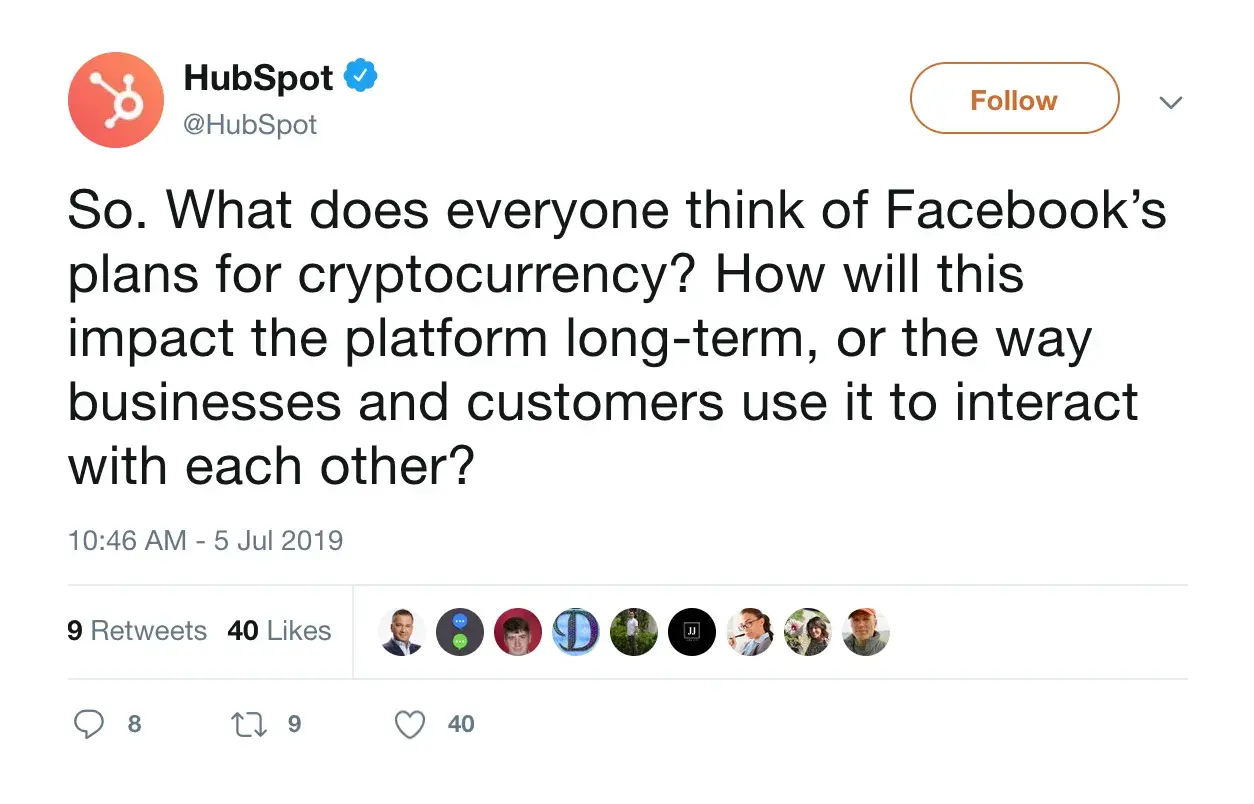
While this particular topic isn’t necessarily related to HubSpot’s product or industry, it is related to business and digital marketing and is a discussion its potential customers are interested in.
This shows we understand our audience and what’s on their minds and are also up to date on what’s going on in the world.
16. Experiment and refine.
Clearly, there is no shortage of best practices for social media, but the truth is that every audience is different, so you'll want to run experiments to figure out what works best for your brand.
HubSpot’s Kearns shared, “Social is the one channel where you have an opportunity to experiment and get audience feedback on a daily basis. Try new things, iterate, and optimize! Take learnings from your audience and apply them to future content.”
There are endless experiments you can conduct on your channels. Here are some ideas to inspire you:
- Use questions and statistics in your copy to see which pulls your audience in more.
- Test different link positions to determine if it makes users more likely to click.
- Add emojis to see if it increases interactions.
- Run ads to a video and a still image on the same topic to see which performs better.
- Segment a different part of your audience to test how they react to an ad.
- Test different hashtags to see if it affects impressions.
- Spend more time replying to posts to determine if it increases your follower count.
Experimenting with your content is how you figure out your own best practices, which will always be more personalized than industry standards.
Put the spark back in B2B social media.
With the tips and strategies we outlined, B2B social media marketing doesn’t have to be boring, stoic, or forgettable. The key is simply to know your audience and their goals and let their preferences guide you.
The more you listen to their feedback and take lead from their behaviors, the better equipped you will be to craft a social media strategy that drives real bottomline results.
Social Media Marketing


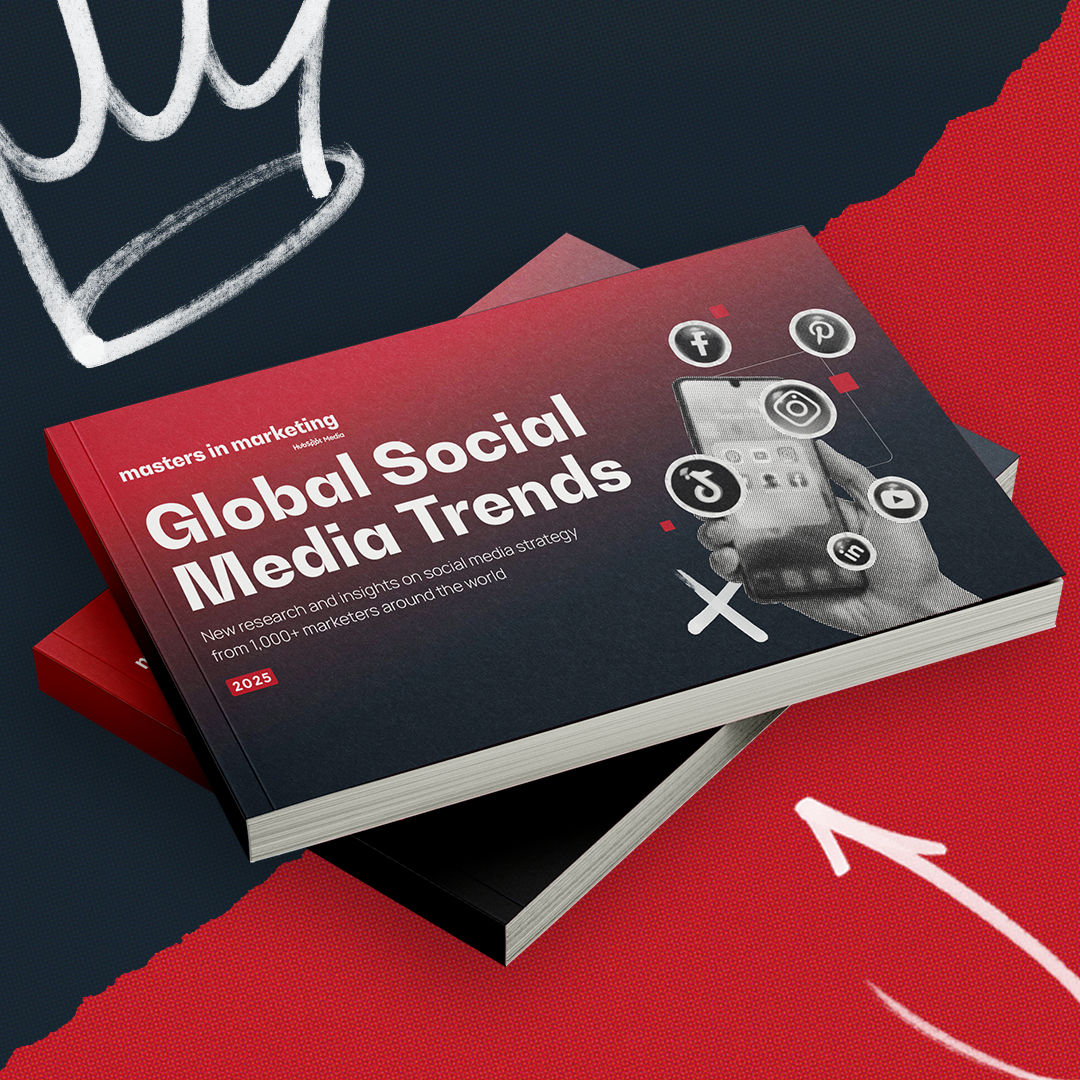

![Social Media Copywriting: Expert Tips for Composing Text on 5 Different Platforms [Bookmarkable]](https://53.fs1.hubspotusercontent-na1.net/hubfs/53/social%20media.png)

.jpg)
![Why Consumers Still Hesitate to Shop on Social Media Platforms [New Data]](https://53.fs1.hubspotusercontent-na1.net/hubfs/53/why%20people%20are%20buying%20products%20from%20social%20media.jpg)




